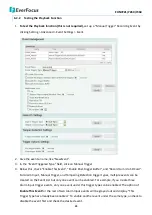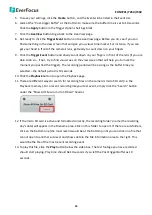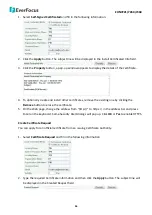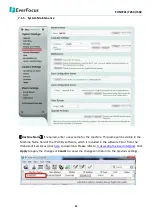
EHN7221/7260/7360
35
server providers, you have to register your name with the provider first, and then select the
provider and fill in the required information. Please refer to the specific DDNS company’s
website for further information.
Record ID: Type the record ID if provided by the DDNS server provider.
FQDN: Type the fully qualified domain name applied from the DDNS server provider. For
example, xxxx.dyndns.com
Username / Password: Type the login account of your DDNS server provider.
Click
Apply
to apply the changes or
Cancel
to cancel the changes and return to the previous
settings.
Note:
1.
In order to support the full functionality of the camera, you must open the port numbers (80,
554, 443) on the router for remote access to the IP camera. This function is available on most
routers in the market and is often known as “Port Forwarding”. To set up Port Forwarding,
please refer to
Appendix D. Setting up Port Forwarding Function
.
2.
In certain router models, it is possible that you will not be able to access the camera using
DDNS while inside the router’s network. Please try using a PC located outside of your router’s
network.
Default Ports on All EverFocus IP Cameras:
HTTP: 80
RTSP: 554
HTTPS: 443
3.
The host name obtained from EverFocus DDNS server or other DDNS server should not
include a space, underline or any special characters particularly _~ ! @ # $ % ^ & * ( ) + < >
" ; : . ,
【
HTTPS Settings
】
This function can only be set up in the
Advanced
tab. Hypertext Transfer Protocol
Secure (HTTPS) is a combination of the Hypertext Transfer Protocol and the SSL / TLS protocol that
provides encrypted communication and secure identification of a network web server. Before using
the HTTPS function for communication with the IP camera, a Certificate must be created first. There
are two ways to create and install a certificate:
Self-Signed Certificated
and
Certificate Request
.
Self-Signed Certificated
Please note that even though self-signed certificates are free and offer some protection, true
security is only implemented after the installation of a signed certificate issued by a certificate
authority.
















































